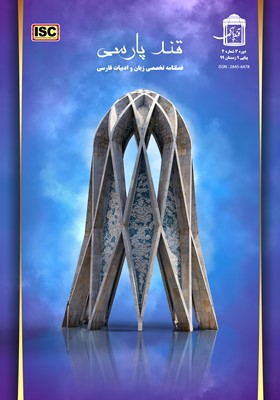کارکردهای صفات شاعرانه در غزلیات حافظ
محورهای موضوعی : تحلیل متون نظم
1 - دانشگاه فرهنگیان
کلید واژه: غزلیات حافظ, صفات شاعرانه, کارکردشناسی, زیبانمایی, زشتنمایی, بزرگنمایی,
چکیده مقاله :
صفات شاعرانه (epithets) صفاتی هستند که بر خلاف صفات دستوری و منطقی، کارکردهای هنری و شاعرانه دارند و با ارائة جزئیاتی هنری و زیباییشناسانه از موصوف، موجب تشخّص و برجستگی در زبان شعر میشوند. از آنجا که حافظ به اذعان اغلب پژوهشگران، در کشف، ساخت و کاربرد اینگونه صفات توانا بوده است، درحالیکه شگردهای هنری او در این باره بهخوبی کاویده نشده، نگارنده کوشیده است تا در قالب این مقاله و با استفاده از روش تحلیل محتوا، این موضوع را در غزلیات حافظ بررسی کند. بر اساس این بررسی مشخص شده است که حافظ بیش از 1400 ترکیب وصفی، 560 صفت جانشین موصوف و 58 گروه وصفی ساخته که از این تعداد، بالغ بر 480 صفت، از نوع شاعرانهاند؛ یعنی کارکردهای هنری و شاعرانه دارند و موجب برجستگی زبان شدهاند. این صفات در این مقاله بر اساس نوع کارکرد تجزیه و تحلیل شدهاند و مشخص شده که این صفات کارکردهای زیبانمایی (سرو صنوبرخرام)، زشتنمایی (صوفی دجالفعل ملحدشکل)، بزرگنمایی (زبان آتشین)، استعاری (اشک غماز)، کنایی (کوتهآستینان)، تشبیهی (دل صنوبری)، تلمیحی (آدم بهشتی) و ایجازی (کبک خوشخرام) دارند و چون اغلب آنها با نوعی ابداع و خیالانگیزی همراه هستند، موجب تشخّص در زبان شعر شدهاند و حافظ از این منظر نیز شاعر بزرگی است. این موضوع قابل بررسی در شاهکارهای ادبیای چون شاهنامه و بوستان است که در آن صورت، تفاوت صفات شاعرانه در انواع ادبی نیز به دست میآید.
Epithets are attributes that, unlike attributes in the grammatical and logical sense, have many artistic and poetic functions, and in this way, cause the poetry language to be distinguished.Hafez is superior in the discovery, construction, and use of this type of epithets, but his artistic techniques have not been well studied yet, and as a result, most of the opinions on this subject are presented just about a few of his poems; so the present paper tried to examine this issue in Hafez’ sonnetsscientifically using the content analysis. According to this paper, it has been determined that Hafez has over 1400 descriptive compositions, 560 successor attributes, and 58 descriptive groups, from which more than 480 are epithets; that is, they have aesthetic function and made the language prominence. These epithets are analyzed in this paper based on the type of function, and it has been determined that the epithets of Hafez in his sonnets have the functions of beatification (Sarve Senoubarkharaam), uglification (Dajal Fe’l Molhedolshekl), magnification (Zabaane Atashin), metaphorical (Ashke ghammaz), sarcastic(Kootah Astinaan), simile (Dele senoubari) and allegory (Adame Beheshti). Since most of them are associated with a kind of innovation and fantasizing, they have cause the poetic language to be prominent and distinguished; therefore, Hafez is a great poet in this regard. This issue can be studied on literary masterpieces such as Shahnameh and Boostan by which the different epithets can be found in literary genres.
